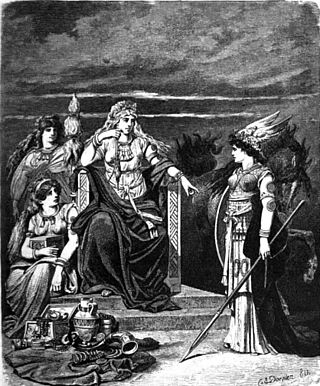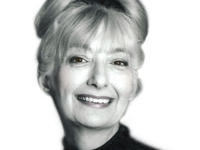Related Research Articles

Dianic Wicca, also known as Dianic Witchcraft, is a modern pagan goddess tradition focused on female experience and empowerment. Leadership is by women, who may be ordained as priestesses, or in less formal groups that function as collectives. While some adherents identify as Wiccan, it differs from most traditions of Wicca in that only goddesses are honored.

Frigg is a goddess, one of the Æsir, in Germanic mythology. In Norse mythology, the source of most surviving information about her, she is associated with marriage, prophecy, clairvoyance and motherhood, and dwells in the wetland halls of Fensalir. In wider Germanic mythology, she is known in Old High German as Frīja, in Langobardic as Frēa, in Old English as Frīg, in Old Frisian as Frīa, and in Old Saxon as Frī, all ultimately stemming from the Proto-Germanic theonym *Frijjō. Nearly all sources portray her as the wife of the god Odin.

In Norse mythology, Eir is a goddess or valkyrie associated with medical skill. Eir is attested in the Poetic Edda, compiled in the 13th century from earlier traditional sources; the Prose Edda, written in the 13th century by Snorri Sturluson; and in skaldic poetry, including a runic inscription from Bergen, Norway from around 1300. Scholars have theorized about whether these three sources refer to the same figure, and debate whether Eir may have been originally a healing goddess or a valkyrie. In addition, Eir has been compared to the Greek goddess Hygieia.
In Greek mythology, Apate is the goddess and personification of deceit. Her mother is Nyx, the personification of the night. In Roman mythology her equivalent is Fraus, while her male counterpart is Dolos, a minor god of trickery, and her opposite number Aletheia, the goddess of truth.
Aradia is one of the principal figures in the American folklorist Charles Godfrey Leland's 1899 work Aradia, or the Gospel of the Witches, which he believed to be a genuine religious text used by a group of pagan witches in Tuscany, a claim that has subsequently been disputed by other folklorists and historians. In Leland's Gospel, Aradia is portrayed as a messiah who was sent to Earth in order to teach the oppressed peasants how to perform witchcraft to use against the Roman Catholic Church and the upper classes.
In Norse mythology, Lofn is a goddess. Lofn is attested in the Prose Edda, written in the 13th century by Snorri Sturluson and in kennings found in skaldic poetry. In the Prose Edda, Lofn is described as gentle in manner and as an arranger of marriages, even when they have been forbidden. Scholars have proposed theories about the implications of the goddess.
The White Goddess: a Historical Grammar of Poetic Myth is a book-length essay on the nature of poetic myth-making by the English writer Robert Graves. First published in 1948, the book is based on earlier articles published in Wales magazine; corrected, revised and enlarged editions appeared in 1948, 1952 and 1961. The White Goddess represents an approach to the study of mythology from a decidedly creative and idiosyncratic perspective. Graves proposes the existence of a European deity, the "White Goddess of Birth, Love and Death", much similar to the Mother Goddess, inspired and represented by the phases of the Moon, who lies behind the faces of the diverse goddesses of various European and pagan mythologies.
The Triple Goddess is a deity or deity archetype revered in many Neopagan religious and spiritual traditions. In common Neopagan usage, the Triple Goddess is viewed as a triunity of three distinct aspects or figures united in one being. These three figures are often described as the Maiden, the Mother, and the Crone, each of which symbolizes both a separate stage in the female life cycle and a phase of the Moon, and often rules one of the realms of heavens, earth, and underworld. In various forms of Wicca, her masculine consort is the Horned God.

The Goddess movement includes spiritual beliefs or practices that emerged predominantly in North America, Western Europe, Australia, and New Zealand in the 1970s. The movement grew as a reaction to Abrahamic religions, which have only gods with whom are referred by male pronouns, and it uses goddess worship and may include a focus on women or on one or more understandings of gender or femininity.

A magic circle is a circle of space marked out by practitioners of some branches of ritual magic, which they generally believe will contain energy and form a sacred space, or will provide them a form of magical protection, or both. It may be marked physically, drawn in a material like salt, flour, or chalk, or merely visualised.
Rachel Grace Pollack was an American science fiction author, comic book writer, and expert on divinatory tarot.
Drawing down the Moon is a central ritual in many contemporary Wiccan traditions. During the ritual, a coven's High Priestess enters a trance and requests that the Goddess or Triple Goddess, symbolized by the Moon, enter her body and speak through her. The High Priestess may be aided by the High Priest, who invokes the spirit of the Goddess. During her trance, the Goddess is supposed to speak through the High Priestess.
Béḃinn or Bé Binn, in modern orthography Béibhinn, is an early Irish personal and mythological name. In some sources Béḃinn is a goddess associated with birth and the sister of the river-goddess, Boann. Béḃinn is also described as being an underworld goddess in both Irish and Welsh mythology, inhabiting either the Irish underworld Mag Mell or the Welsh Annwn, although it is unknown which is the original source.

Patricia Monaghan was a poet, a writer, a spiritual activist, and an influential figure in the contemporary women's spirituality movement. Monaghan wrote over 20 books on a range of topics including Goddess spirituality, earth spirituality, Celtic mythology, the landscape of Ireland, and techniques of meditation. In 1979, she published the first encyclopedia of female divinities, a book which has remained steadily in print since then and was republished in 2009 in a two volume set as The Encyclopedia of Goddesses and Heroines. She was a mentor to many scholars and writers including biologist Cristina Eisenberg, poet Annie Finch, theologian Charlene Spretnak, and anthropologist Dawn Work-MaKinne, and was the founding member of the Association for the Study of Women and Mythology, which brought together artists, scholars, and researchers of women-centered mythology and Goddess spirituality for the first time in a national academic organization.

Merlin Stone was an American author, artist and academic. She was an important thinker of the feminist theology and Goddess movements and is known for her book When God Was a Woman.
Amber K is the Pagan/Craft name (pseudonym) of Kitty Randall, an author of books about magick, Wicca and Neopaganism, and a third-degree priestess of the Wiccan faith. She was initiated at the Temple of the Pagan Way in Chicago, Illinois, and served on the Council of Elders there, and has taught the craft throughout the United States for over 30 years. She has served as National First Officer of the Covenant of the Goddess for three terms, and is a founder of Our Lady of the Woods and the Ladywood Tradition of Wicca. She has worked with various Neopagan organizations such as Circle Sanctuary and the Re-Formed Congregation of the Goddess, and a Grey Council member of the online Grey School of Wizardry founded by Oberon Zell Ravenheart in 2004. She is the executive director of Ardantane, a non-profit Wiccan and pagan school and seminary in northern New Mexico.
Patricia "Trish" Telesco is an American author, herbalist, poet, lecturer, Wiccan priestess, and folk magician who has written more than 60 books on a variety of subjects ranging from self-help and cookbooks to magic, folklore and global religion. Articles by Telesco have appeared in several mainstream publications such as Cosmo, Woman's World, and Cats' Magazine, and in such Neopagan publications such as Circle Network News and popular websites such as The Witches' Voice.
Deanna "D. J." Conway was a non-fiction author of books in the field of magic, Wicca, Druidism, shamanism, metaphysics and the occult, and the author of three fantasy novels. Born in Hood River, Oregon to a family of Irish, North Germanic, and Native North American descent, she studied the occult and Pagan religion for over thirty years. In 1998 she was voted Best Wiccan and New Age author by Silver Chalice, a Neo-Pagan magazine. She was an ordained minister in two New Age churches and holder of a Doctor of Divinity degree. Several of her stories were published in magazines, such as the science fantasy publication Encounters, and she was interviewed in magazines and appeared on such television shows as Journey with Brenda Roberts. She also designed Tarot decks, in collaboration with fellow author Sirona Knight and illustrator Lisa Hunt.
Dorothy Morrison is an author and teacher in the fields of magic, Wicca and Neo-Paganism. She is a Third Degree Wiccan High Priestess of the Georgian Tradition, and founded the Coven of the Crystal Garden in 1986. She is a member of the Coven of the Raven, and studies the RavenMyst Circle Tradition. Originally from Texas, she is an expert archer, a former staff writer for several bow-hunting magazines, and winner of three State Championship titles. She has also been an administrator for the Humane Society. She is a member of the Pagan Poets Society and a charter member of M.A.G.I.C., a magical writers and artists organization. Her work has been published in many journals and magazines, including Circle Network News, SageWoman, and Crone Chronicles. She presently lives in Northern Virginia with her husband Mark.
Cochrane's Craft, which is also known as Cochranianism, is a form of traditional witchcraft founded in 1951 by the English witch Robert Cochrane, who himself claimed to have been taught in the tradition by some of his elderly family members, a claim that is disputed by some historians such as Ronald Hutton and Leo Ruickbie.
References
- 1 2 Monaghan, Patricia (1997). The New Book of Goddesses & Heroines. Llewellyn Publications. ISBN 9781567184655.
- ↑ Eason, Cassandra (2001). The Complete Book of Women's Wisdom. Piatkus. ISBN 9780749922092.
- ↑ Auset, Brandi (2009). The Goddess Guide: Exploring the Attributes and Correspondences of the Divine Feminine. Llewellyn Worldwide. ISBN 9780738715513.